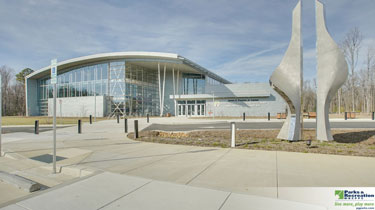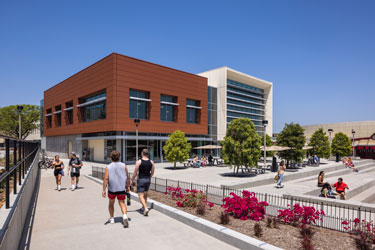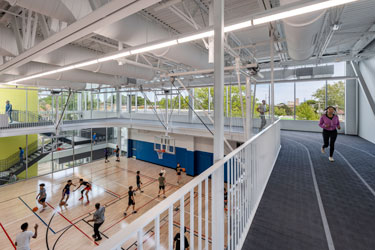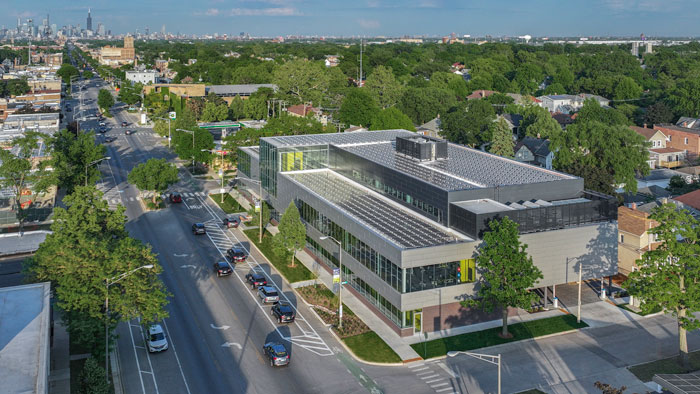What does eco-minded recreation facility design have in common with basketball legend LeBron James? Both are focused on conserving as much energy as possible while still achieving peak performance.
Looking solely at overall energy expenditure, James comes across as pokey. During the 2018 finals, he clocked in as the slowest player on the court, averaging just 3.73 miles per hour. But James (who in that same series logged about 50 more minutes of gametime than any other player) is anything but lazy. He’s eminently efficient, having mastered the art of saving and expending energy as needed.
Other high-energy athletes, such as swimmers and boxers, likewise strategize to accumulate what James calls reserve

“pockets of energy.” Clearly for James, the approach works not only during the heat of competition—he’s the all-time leading scorer in NBA history—but also over the long haul. While the average NBA career lasts just 4.5 years, James is the picture of longevity, with a pro tenure spanning two decades.
Recreation facilities, like top athletes, use massive amounts of energy. Their high energy consumption is due to their size and layout, the need for artificial lighting, the demands of heating and cooling, and continual equipment usage. Some facilities have the added drain of round-the-clock operations. Others feature indoor aquatic centers or ice arenas, which are notorious energy hogs.
It’s no wonder rec facility managers want to make like LeBron James and conserve as much energy as possible.
Before parting ways with James to focus on facility design, let’s draw one more comparison between the basketball star and rec facilities that attain the highest standards of eco-friendliness. While James takes measures to enhance his proficiency, he came into this world with good genes. Likewise, facilities can always be made to function more sustainably, but the greenest among them were probably built that way, with eco-friendliness woven into their DNA.
Green From the Get-Go
Take, for example, San Diego State University’s Aztec Recreation Center (called “the ARC” for short), which received LEED Platinum Certification for New Construction in 2023 and is poised to achieve LEED Double Platinum status by qualifying for a second certification, LEED Platinum for Existing Buildings: Operations and Maintenance. The latter designation will certify that the ARC is operating sustainably and meeting LEED benchmarks.
The student body drove the decision to seek the highest LEED certification and voted to increase student fees to cover the associated costs. Input and buy-in from students and other stakeholders brought goals into focus—and within reach.
“The students wanted the project to exemplify the future of construction,” said Mark Zakrzewski, associate executive director of the university’s Associated Students organization, which manages the ARC. “If you’re thoughtful about planning on the front end, such ambitions are very achievable.”
The community input process and subsequent design phase are when sustainability becomes an integral part of a
project’s DNA. The RFP (request for proposal) for the ARC’s design specified that the building must receive LEED Platinum certification and that bidders should have experience designing to those standards as well as expertise in design elements that earn LEED points. For example, investing in insulation with a high R-value upfront so as to reduce heating and cooling costs in the long run was a high priority for the university.
“You have to be really assertive with your architect and contractors about your priorities and non-negotiables from the very beginning,” said Charlotte Roberts, sustainability coordinator for Associated Students. “Because buildings tend to end up costing more than what was estimated in the conceptual phase, value engineering starts to happen, which is the process of identifying ways to bring down costs. People don’t see insulation, so that would be a tempting downgrade to make” had stakeholders not been decisive and insistent about R-value requirements.

Other upfront costs were incurred in the form of a highly detailed feasibility study, which produced not only a clear vision with a realistic budget but also “fantastic renderings and amazing video of what the facility would look like, so folks could understand what we were aiming for and see that it’s possible to achieve,” Zakrzewski said.
And what designers achieved is impressive. The 134,000-square-foot recreation center houses an indoor track, six multiuse courts, five group fitness studios, a 41-foot climbing wall, and 25,000 square feet of weight and cardio equipment space. LEED certification is based on a point system, and the ARC sailed past the 80-point requirement for Platinum status, earning a total of 90 points.
The ARC’s sustainable design elements are too numerous to list but include a 375-kilowatt rooftop solar power system as well as collection tanks beneath the courtyard that store up to 200,000 gallons of rainwater and HVAC condensate, which is used for low-flow toilets and outdoor drip irrigation.
But what really sets the facility apart is its all-electric operations. There are no natural gas boilers, which have long been the norm for such high-energy buildings. And while California has enacted policies to incentivize or mandate the use of renewable energy in new construction projects, the university’s decision was voluntary—and visionary. “I’ve talked with several colleagues, and I have yet to hear about another project of this type that’s fully electric. This is the future of construction, and we’re proud to be on the forefront,” Zakrzewski said.
Higher Standards Across the Board
Across the country, in Maryland, Glenn Ryan enjoys views of a park through his office windows. It’s wintertime, and the
grounds are white with snow. Nevertheless, Ryan is seeing green. That’s because the greening of parks and rec facilities is a requirement of his job.
Ryan is the design and construction project manager for the Maryland-National Capital Park and Planning Commission. Like many parks and rec administrations in the U.S., the commission has set a minimum eco-friendliness standard, requiring all new buildings to meet LEED Silver qualifications even if official LEED certification is not sought. (The amount of paperwork and documentation required is an added strain on resources.)
So, during the design and construction of the Southern Area Aquatics and Recreation Complex (SAARC) in Brandywine, Md., Ryan accrued points in each of the categories in LEED’s rating system: sustainable siting, water efficiency, energy and atmosphere, materials and resources, innovation and design process, and regional priority.
Through expansive areas of glass that welcome an abundance of natural light, the 70,000-square-foot building offers a picturesque view of the site’s heritage tree, a 175-year-old willow oak. A bioretention pond features plantings that naturally filter out stormwater discharge, thereby protecting the watershed.
Along with fitness rooms, a gymnasium and an indoor track, SAARC houses an aquatics center with a six-lane swimming pool, a plunge pool with a spiral slide, and a large hot tub area. To conserve water, a 10,000-gallon-capacity cistern collects rainwater that deflects off the solar-reflective roof, which meets the scaled-back irrigation needs of landscaping consisting of native plants. Low-flow plumbing fixtures throughout the building reduce water consumption by 35% compared to a normal baseline building.
The power purchased for building operations comes from 100% non-fossil-fuel sources including solar and wind power. Recycled materials and sustainably harvested woods were used throughout the facility. Construction waste was tracked with the initial goal of diverting 75% of it from the landfill, but the contractor exceeded that goal with 89% diversion.
Like Zakrzewski and Roberts, Ryan emphasizes the importance of community input and careful planning and added that it’s critical to devise a way to make sure sustainability efforts stay on track. Take the long view, he said, because higher upfront costs for eco-friendly features pay off down the road. After all, the commission keeps buildings in inventory for about 50 years, ensuring an ample return on investment and high performance throughout their lifespan.
To further ensure that SAARC will function with LeBron James-like efficiency, the project included enhanced commissioning.
“Basically, you get a commissioning engineer on board at the very beginning of the design process, and they stay with
you all the way through construction to make sure you’re meeting your goals in terms of energy consumption and conservation,” Ryan explained.

The engineer—with specialized LEED expertise—creates a report evaluating operational efficiency at startup and again at the one-year mark, identifying optimization opportunities.
At the ARC in San Diego, management is engaged in commissioning to earn a second LEED Platinum plaque for operations and maintenance. The process verifies the use of green cleaning products and maintenance practices, evaluates one year’s worth of utility data, and requires a waste audit for which “we literally dump all of our trash and recycling and compost bins out on the ground and sift through it to categorize all the waste and come up with a diversion rate,” Roberts said.
To quote Kermit the Frog, “It’s not easy being green.”
Zero—the Perfect Score
It may not be easy, but increasingly, going green is expected. Many communities have set standards for sustainable parks and rec development, with some moving toward a net-zero energy standard as opposed to—or in addition to—LEED certification. Buildings that meet the standard produce enough renewable energy to cover their own annual energy consumption requirements.
As part of its “Green Spaces, Green Places” Energy Action Plan, Ramsey County Parks and Recreation in Minnesota instituted a net-zero energy requirement for new or redeveloped park restroom, shelter and pavilion projects. Larger building projects are designed to be “solar-ready,” with roofs and electrical distribution systems designed to support future solar installations. Where roof-mounted solar isn’t feasible, locations for future ground-mounted installations are identified. The feasibility study that led to this practice found that “a lot of park facilities use so little energy that retrofitting solar panels was not cost-effective; that’s why we adjusted our renewable energy strategies in parks to focus on net-
zero energy redevelopments rather than retrofits,” said Eve Onduru, the county’s deputy director of communications and public relations.
The parks and recreation department is engaged in a Guaranteed Energy Savings Project with financing that allows facilities to complete energy-saving improvements within an existing budget by paying for them with money saved through reduced utility expenditures over time.
Instituting net-zero energy requirements for larger facilities like recreation centers isn’t feasible for the county at this time. “Net-zero becomes more challenging in larger, more heavily occupied facilities,” Onduru said. “A net-zero facility will usually require renewable energy to offset energy consumption, but often potential solar locations on a site are limited, and there is only so much roof or ground space available.”

Another Midwest community proves that net-zero energy for large recreation facilities poses challenges, but it’s not impossible—especially with $1.78 million in grant funding. The Park District of Oak Park, Ill., a suburb of Chicago, worked with the design firm Perkins&Will to erect the Community Recreation Center (CRC), a three-story, 42,000-square-foot brick, metal and glass building that is expected to save up to $80,000 annually on energy costs by using solar power generated onsite, and the building is so efficient to begin with that it uses less than a third of the energy that a baseline building would consume. Special treadmills in the fitness area also harvest user-generated energy.
The Illinois Clean Energy Community Foundation awarded the grant with the stipulation that the building attain a third-party net-zero certification, which the facility is slated to receive through the International Living Future Institute’s Zero Energy initiative.
A host of design elements provide for net-zero energy performance, including a triple-glazed argon-filled curtain wall system, a green roof and increased insulation values. Arrays of photovoltaics on the roof, south façade and a canopy on the adjacent parking lot generate enough energy to exceed demands of the building. And onsite battery storage is sufficient to power the building independent of the grid, allowing the facility to serve the community as a heating or cooling center during outages.
For a high-volume facility like a rec center, net-zero is a “substantially more difficult” goal than earning points for LEED’s energy category, said Design Director Bryan Schabel, a principal at Perkins&Will.
Project Manager Brent Ross, who leads the Sports, Recreation and Entertainment practice in the firm’s Chicago studio, added that designers “maxed out” every available square inch of space for solar panels and described the net-zero energy goal “difficult but doable” for rec facilities.
Financially, it’s worth the effort. “One of the prime concerns of our clients is, ‘How much is it going to cost to go to net-zero?’ The difference in construction costs (for CRC) was 11%, so it’s well within reach for most clients to achieve net-zero, and there are financial benefits down the line,” Ross said.
In addition to the usual cardio machines, the building houses an e-sports lounge with electronic gaming equipment, so facility managers rely on a building automation system to power down those assets at night.
The funding program requires grantees to provide education opportunities to teach residents about the facility’s energy-efficient features, so the rec center will have signage and an energy usage display to illustrate how the building is constructed and how it performs. The park district will continually monitor energy benchmarks for net-zero energy compliance, which is required for the final portion of the grant.
‘Nothing But Net’ Is Not the Intent
Although net-zero is an ambitious and worthwhile goal, it’s “one piece of a broader approach to sustainable design,” Ross said. “So, certainly, our goal is to design buildings that produce renewable energy onsite to reduce our dependence on fossil fuels and reduce our carbon footprint. But there are other aspects, like air quality and water conservation, that need and should be addressed.”
To that end, the CRC’s design specs called for a bioswale to manage stormwater and EPA Indoor Air Plus-rated paints and materials.
While parks and rec budgets are often constrained, districts from coast to coast are otherwise well-positioned to take on a leadership role in sustainability. “Demonstrating best practices or exemplary approaches to sustainable design really aligns with their own mission and goals as an organization, which is all about preserving natural green space and doing what’s best for the environment,” Ross said. “And they have direct access to the community, and so educating the community as part of the project can broaden acceptance of, and support for, sustainability initiatives in general.” RM



